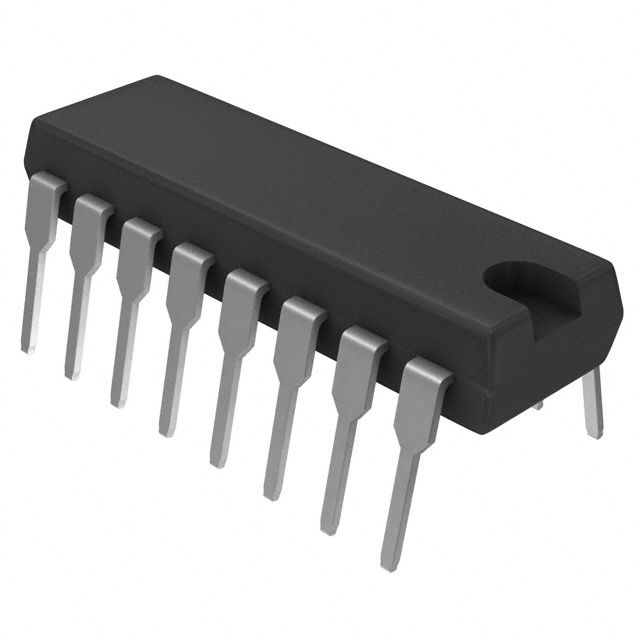ADG408BN
Product Overview
- Category: Analog Switches
- Use: Signal Routing and Switching
- Characteristics: High Precision, Low Power Consumption
- Package: DIP (Dual Inline Package)
- Essence: Analog Multiplexer/Demultiplexer
- Packaging/Quantity: Tube/25 pieces
Specifications
- Number of Channels: 8
- On-Resistance: 125 Ohms (typical)
- Supply Voltage Range: ±4.5V to ±18V
- Operating Temperature Range: -40°C to +85°C
- Switching Time: 200 ns (typical)
Pin Configuration
The ADG408BN has a 16-pin DIP package with the following pin configuration:
- IN1
- IN2
- IN3
- IN4
- IN5
- IN6
- IN7
- IN8
- GND
- COM
- NO1
- NO2
- NO3
- NO4
- NO5
- V+
Functional Features
- High precision analog signal routing and switching.
- Low power consumption for energy-efficient operation.
- Wide supply voltage range allows compatibility with various systems.
- Fast switching time ensures quick response in signal routing applications.
Advantages and Disadvantages
Advantages: - High precision in signal routing and switching. - Low power consumption for energy efficiency. - Wide supply voltage range for compatibility. - Fast switching time for quick response.
Disadvantages: - Limited number of channels (8). - Not suitable for high-frequency applications.
Working Principles
The ADG408BN is an analog multiplexer/demultiplexer that routes or switches analog signals between multiple channels. It operates by controlling the on/off state of internal switches, allowing the selection of a specific channel for signal transmission. The low on-resistance ensures minimal signal distortion during routing.
Detailed Application Field Plans
The ADG408BN finds applications in various fields, including:
- Audio Systems: Signal routing in audio mixers and amplifiers.
- Test and Measurement: Channel switching in test equipment.
- Communication Systems: Signal routing in telecommunication devices.
- Industrial Control: Analog signal switching in control systems.
- Medical Equipment: Channel selection in medical monitoring devices.
Alternative Models
- ADG408BRZ: RoHS-compliant version with similar specifications.
- ADG408BRUZ: Smaller package (TSSOP) alternative with comparable performance.
- ADG408BR: Surface-mount version with extended temperature range.
(Note: This is not an exhaustive list; please refer to the manufacturer's documentation for more alternatives.)
This entry provides an overview of the ADG408BN analog switch, including its product category, use, characteristics, package, specifications, pin configuration, functional features, advantages and disadvantages, working principles, application field plans, and alternative models.
Senaraikan 10 soalan dan jawapan biasa yang berkaitan dengan aplikasi ADG408BN dalam penyelesaian teknikal
Sure! Here are 10 common questions and answers related to the application of ADG408BN in technical solutions:
Q: What is ADG408BN? A: ADG408BN is a multiplexer/demultiplexer IC (integrated circuit) that allows for the selection of one input from multiple inputs or routing of one output to multiple outputs.
Q: What is the maximum voltage rating for ADG408BN? A: The maximum voltage rating for ADG408BN is typically ±22V.
Q: How many channels does ADG408BN have? A: ADG408BN has 8 channels, meaning it can handle up to 8 different inputs or outputs.
Q: What is the on-resistance of ADG408BN? A: The on-resistance of ADG408BN varies depending on the specific channel, but it is typically around 100 ohms.
Q: Can ADG408BN be used with both analog and digital signals? A: Yes, ADG408BN can be used with both analog and digital signals, making it versatile for various applications.
Q: What is the power supply range for ADG408BN? A: ADG408BN operates with a power supply range of ±4.5V to ±18V.
Q: Is ADG408BN suitable for high-frequency applications? A: ADG408BN is not specifically designed for high-frequency applications, as its bandwidth is limited. It is more commonly used in low to moderate frequency applications.
Q: Can ADG408BN handle bidirectional signals? A: No, ADG408BN is unidirectional and cannot handle bidirectional signals. For bidirectional applications, a separate IC or circuitry may be required.
Q: What is the typical switching time for ADG408BN? A: The typical switching time for ADG408BN is around 100 ns, which is relatively fast for most applications.
Q: Can ADG408BN be cascaded to increase the number of channels? A: Yes, multiple ADG408BN ICs can be cascaded together to increase the number of channels and expand the functionality of the system.
Please note that these answers are general and may vary depending on the specific datasheet and application requirements.


